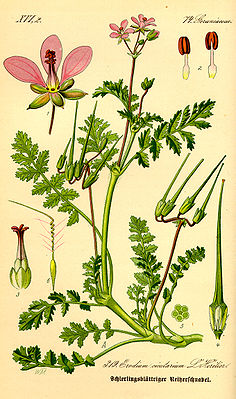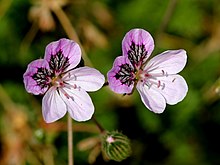Egret's beaks
| Egret's beaks | ||||||||||||
|---|---|---|---|---|---|---|---|---|---|---|---|---|

Common herons beak ( Erodium cicutarium ), illustration |
||||||||||||
| Systematics | ||||||||||||
|
||||||||||||
| Scientific name | ||||||||||||
| Erodium | ||||||||||||
| L'Hér. ex Aiton |


The erodium ( Erodium ) are a plant kind from the family of geraniaceae (Geraniaceae). The approximately 60 to 75 species of the genus are distributed worldwide. They are mainly found in the temperate zones in Europe, Africa and Australia.
description
They are annual , biennial or herbaceous perennials . The plant parts are hairy. The mainly in basal rosettes and arranged opposite or alternate, stalked leaves are simple or compound, often finely pinnate. Stipules are present.
The flowers are rarely solitary, usually in pairs to nine in terminal or axillary dold-like inflorescences . The stalked, often small, five-fold, radially symmetrical to weakly zygomorphic , hermaphrodite flowers . They are those of the genus geranium ( Geranium similar). The five sepals are free. The five free, nailed petals have colors from pink to purple to blue. There is a discus. There are two circles with five stamens each, only five of them are fertile ; the staminodes are between the fertile stamens. Five carpels have become a top permanent ovary grown. There is only one ovule in each of the five ovary compartments . The stylus ends in five pits.
The split fruits are like all Geraniaceae cranesbill-shaped and split into five solitary partial fruits. The bristly "fruit beak" (the awn ), when ripe, curls up tightly in the traditional sense of winding , due to the drying of screwy inner structures .
Types (selection)
Central European species
- Dune heron beak ( Erodium ballii Jord. )
- Grape heron beak ( Erodium botrys (Cav.) A. Bertol. )
- Great Heron Beak ( Erodium ciconium (L.) L'Hér. )
- Common heron beak ( Erodium cicutarium (L.) L'Hér. Ex Aiton )
- Danish heron beak ( Erodium danicum K. Larsen )
- Blue heron beak ( Erodium gruinum (L.) L'Hér. )
- Glandular heron beak ( Erodium lebelii Jord. )
- Heart-leaf heron-beak or mallow -leaf heron- beak ( Erodium malacoides (L.) L'Hér. )
- Musk Egret's bill ( Erodium moschatum (L.) L'Hér. )
Other European species
- Erodium absinthoides Willd. : It occurs from the Balkan Peninsula and Romania to Turkey and Transcaucasia.
- Erodium acaule (L.) Becherer & Thell. : The home is southern Europe, North Africa and the Middle East.
- Erodium alnifolium cast. : The homeland is Italy, Sicily, Sardinia, Tunisia, Algeria, Morocco and Libya.
- Erodium alpinum L'Hér. , occurs only in central Italy.
- Erodium astragaloides Boiss. & Reut. , occurs only in the Sierra Nevada in Spain.
- Erodium beketowii Schmalh. , occurs only in Ukraine.
- Erodium boissieri Cosson , occurs only in the Sierra Nevada in southern Spain.
- Erodium carvifolium Boiss. & Reut. , occurs only in Spain.
- Erodium chium (L.) Willd. : It occurs in Macaronesia, southern Europe, North Africa and the Middle East.
- Golden yellow heron beak ( Erodium chrysanthum L'Hér. Ex DC. ), Only occurs in Greece, is also cultivated in gardens.
- Corsican heron beak ( Erodium corsicum Léman ), occurs only in Corsica and Sardinia, is also kept in garden culture.
- Erodium crassifolium L'Hér. (Syn. Erodium hirtum (Forssk.) Willd. ): It occurs from North Africa and Crete to the Sinai Peninsula and to Jordan.
- Erodium durcoides Boiss. : It only occurs in Spain.
- Erodium foetidum (L.) L'Hér. , Syn. Erodium petraeum (Gouan) Willd. : It occurs in Spain, France, Morocco and Algeria.
- Erodium guicciardii Heldr. ex Boiss. , occurs only in Albania and northern Greece.
- Erodium guttatum (Desf.) Willd. : It occurs in Spain, Morocco, Algeria, Tunisia, Libya and Egypt to Jordan.
- Erodium hoefftianum C.A.Meyer : It occurs to Turkey and the Crimea from the Balkans and Southeast Europe.
- Erodium laciniatum (Cav.) Willd. : It occurs from the Canary Islands, from North Africa and southern Europe to Western Asia and Pakistan.
- Pyrenean heron beak ( Erodium manescavii Coss. ), Occurs only in the Pyrenees , is also kept in horticulture.
- Erodium maritimum (L.) L'Hér. : It occurs from Spain, the Balearic Islands, France, Corsica, Sardinia, Tunisia and Italy to Great Britain.
- Erodium nervulosum L'Hér. (Syn. Erodium gussonei Ten. ) Occurs only in southern Italy.
- Erodium paui Sennen , occurs only in northern Spain at the Pico der Urbión.
- Balearic heron beak ( Erodium reichardii (Murray) DC. ), Only occurs in the Balearic Islands, is also kept in horticulture.
- Erodium rodiei (Br.-Bl.) Poirion , occurs only in France near Grasse.
- Erodium rupestre (Pourr. Ex Cav.) Guittonneau , occurs only in northeastern Spain.
- Erodium rupicola Boiss. , occurs only in the Sierra Nevada in Spain.
- Erodium ruthenicum M.Bieb. : The homeland is Romania, Ukraine, Moldova, Southern Russia, Georgia and Transcaucasia.
- Erodium sanguis-christi Sennen , occurs only in Eastern Spain.
Non-European species
Here is just a selection:
- Erodium crinitum Carolin : It occurs in Australia.
- Erodium texanum A. Gray : It occurs in the southern United States and northern Mexico.
use
Few types of Erodium, and especially their varieties, are used in gardens and parks as ground cover , for rock gardens or crevices.
photos
Thick-leaved Heron-Beak ( Erodium crassifolium )
Habit , split leaves, flowers and fruits of Erodium foetidum
Flowers of Erodium manescavii
Musk heron beak ( Erodium moschatum )
Web links
swell
- David Allardice Webb, Arthur Oliver Chater: Erodium L. In: TG Tutin, VH Heywood, NA Burges, DM Moore, DH Valentine, SM Walters, DA Webb (Eds.): Flora Europaea . Volume 2: Rosaceae to Umbelliferae . Cambridge University Press, Cambridge 1968, ISBN 0-521-06662-X , pp. 199–204 (English, limited preview in Google Book Search).
- TD Macfarlane: Erodium . In: Western Australian Herbarium (Ed.): FloraBase. The Western Australian Flora. Department of Environment and Conservation 2008.
- Gwen J. Harden: Erodium. In: Gwen J. Harden (Ed.): Flora of New South Wales. Volume 3, New South Wales University Press, Kensington 1992, ISBN 0-86840-172-2 , p. 27, limited preview in Google Book Search, online (with minor changes ).
- Langran Xu, Carlos Aedo: Erodium. In: Wu Zheng-yi, Peter H. Raven, Deyuan Hong (Eds.): Flora of China . Volume 11: Oxalidaceae through Aceraceae . Science Press / Missouri Botanical Garden Press, Beijing / St. Louis 2008, ISBN 978-1-930723-73-3 , pp. 29 (English, online - PDF file ).
- Yasin J. Nasir: Flora of Pakistan 149: Geraniaceae . Department of Botany, University of Karachi u. a., Karachi et al. a. 1983, OCLC 690811671 , Erodium , p. 1-43 (English, online ).
Individual evidence
- ↑ Paul Simons: Plants in motion. Springer, 1994, ISBN 978-3-0348-6184-7 (reprint), p. 41.
- ↑ a b c d e f g h i j k l Aldasoro, J., Sáez, L. & Navarro, C. (2009): Erodium .-– In: Aedo, C., Estébanez, B. & Navarro, C . (ed.); with contributions from Raab-Straube, E. von & Parolly, G .: Geraniaceae. Euro + Med Plantbase - the information resource for Euro-Mediterranean plant diversity. Berlin 2011. [1] .
- ↑ Information at winterharte-stauden.com
- ↑ a b c Werner Greuter, Hervé-Maurice Burdet, Guy Long (eds.): Med Checklist. A critical inventory of vascular plants of the circum-Mediterranean countries . Vol. 3: Dicotyledones (Convolvulaceae - Labiatae) . Conservatoire et Jardin Botanique, Genève 1986, ISBN 2-8277-0153-7 ( online ).
- ↑ http://www.biologie.uni-ulm.de/cgi-bin/query_all/details.pl?id=60775&stufe=A&typ=PFL
- ^ Bochumer Botanischer Verein e. V. Mallorca excursion 2008 of the LÖK-AG of the Ruhr University Bochum
- ^ A b Erodium in the Germplasm Resources Information Network (GRIN), USDA , ARS , National Genetic Resources Program. National Germplasm Resources Laboratory, Beltsville, Maryland.







